Category : Dyno Test & Tune
Back to Blog
Share This
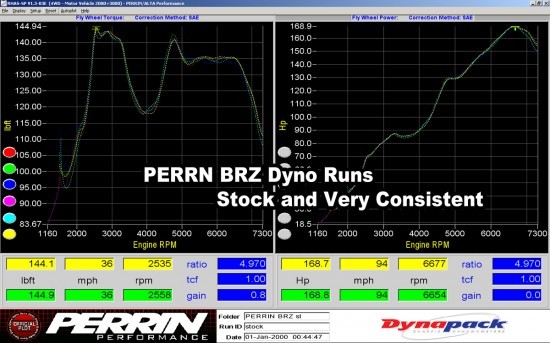 So how does this compare to another dyno? Locally we have Cobb Tuning(Surgline) and they had a chance to dyno a BRZ recently as well. Their dyno is a Mustang Dyno, which typically read low compared to some. We have found our dyno's both read very similar. You can see from the two graphs, that both cars made very similar HP. (168 vs. 164)
So how does this compare to another dyno? Locally we have Cobb Tuning(Surgline) and they had a chance to dyno a BRZ recently as well. Their dyno is a Mustang Dyno, which typically read low compared to some. We have found our dyno's both read very similar. You can see from the two graphs, that both cars made very similar HP. (168 vs. 164)
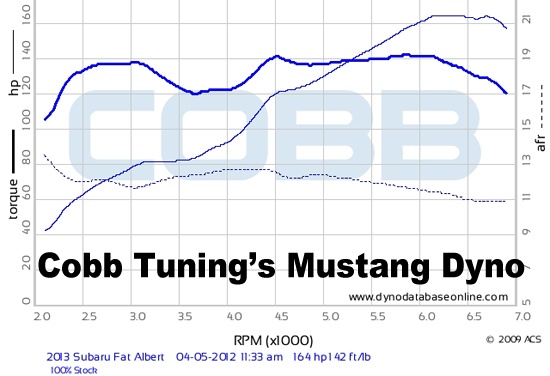 From both our graphs you can see the large dip in torque. This has been up for some debate for a while. Its a 25ft-lbs loss right in the middle of things. There has been speculation that its from cam timing, or fueling or something else. There is still some mystery to this, but I think its done on purpose. Since most people drive in the 1000-4000 range during normal driving this creates a powerband that drives people to shift early and save fuel. Then you have those times where you are shifting at redline, and in these situations you are always about 5000RPM or higher. This falls right into that second hump in TQ and power. Can we tune this out? I say yes, but only time will tell.
From both our graphs you can see the large dip in torque. This has been up for some debate for a while. Its a 25ft-lbs loss right in the middle of things. There has been speculation that its from cam timing, or fueling or something else. There is still some mystery to this, but I think its done on purpose. Since most people drive in the 1000-4000 range during normal driving this creates a powerband that drives people to shift early and save fuel. Then you have those times where you are shifting at redline, and in these situations you are always about 5000RPM or higher. This falls right into that second hump in TQ and power. Can we tune this out? I say yes, but only time will tell.
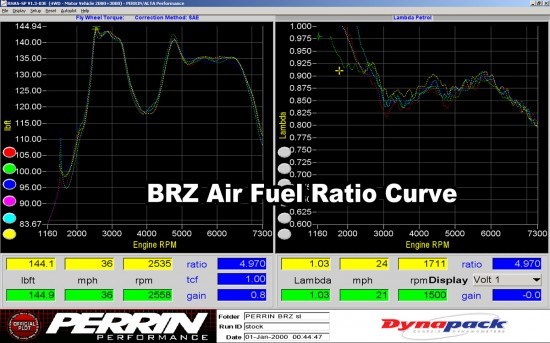 So how does the BRZ run? The data logging parameters are very limited and at best not very accurate with our Innovate Datalogger. What we can see is Air fuel ratio from the dyno. The leaner air fuel ratio was expected, but not the super rich condition from 6500 on up. The 02 sensor is behind two cats and from what we have leaned over the years is that this causes the AFR (air fuel ratio) to leaner than it really is by 1 full point. Meaning if you see 12.0 AFR, its actaully 11.0.
The above graphs are in Lambda which is 14.7 multiplied by the Lambda number. So (.85) Lambda is about 12.5 AFR, but because its behind the cats, its actually 11.5. Which is a very rich AFR for a non turbo car. Especially an efficient direct injection engine like this. What is a safe AFR? There are some basic rules to follow. Under full throttle an engine can run very lean but not for very long as the heat can melt things. "Safe" could be a wide range of AFR. Safe for this engine could be that 10.0-11.5 range. We won't really know until we can start tuning the BRZ. Then we will find out how lean we can run before knock occurs.
What AFR makes the most power? 12.5 AFR is a good range to shoot for. 13.2AFR is a known best TQ AFR, but this is where things could run closer to the edge. Again, we really won't know until we can tune these.
Here is a screen shot of a Logworks run. I logged tons of things and there were a few that makes sense, but a bunch that don't. STFT is always changing under full throttle, but we found evidence that its not active as different MAF housing throw off the AFR. If STFT was actually working, it would compensate.
So how does the BRZ run? The data logging parameters are very limited and at best not very accurate with our Innovate Datalogger. What we can see is Air fuel ratio from the dyno. The leaner air fuel ratio was expected, but not the super rich condition from 6500 on up. The 02 sensor is behind two cats and from what we have leaned over the years is that this causes the AFR (air fuel ratio) to leaner than it really is by 1 full point. Meaning if you see 12.0 AFR, its actaully 11.0.
The above graphs are in Lambda which is 14.7 multiplied by the Lambda number. So (.85) Lambda is about 12.5 AFR, but because its behind the cats, its actually 11.5. Which is a very rich AFR for a non turbo car. Especially an efficient direct injection engine like this. What is a safe AFR? There are some basic rules to follow. Under full throttle an engine can run very lean but not for very long as the heat can melt things. "Safe" could be a wide range of AFR. Safe for this engine could be that 10.0-11.5 range. We won't really know until we can start tuning the BRZ. Then we will find out how lean we can run before knock occurs.
What AFR makes the most power? 12.5 AFR is a good range to shoot for. 13.2AFR is a known best TQ AFR, but this is where things could run closer to the edge. Again, we really won't know until we can tune these.
Here is a screen shot of a Logworks run. I logged tons of things and there were a few that makes sense, but a bunch that don't. STFT is always changing under full throttle, but we found evidence that its not active as different MAF housing throw off the AFR. If STFT was actually working, it would compensate.
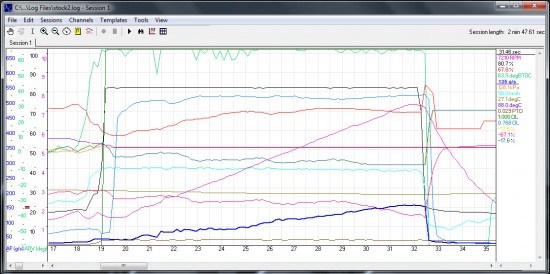 Here are some other comparisons of some other cars. First one is a 2.5RS. When you look at these two cars side by side, you will see that the BRZ will blow the doors off a 2.5RS. You then add the weight factor to it and you really have a much faster car with the BRZ.
Here are some other comparisons of some other cars. First one is a 2.5RS. When you look at these two cars side by side, you will see that the BRZ will blow the doors off a 2.5RS. You then add the weight factor to it and you really have a much faster car with the BRZ.
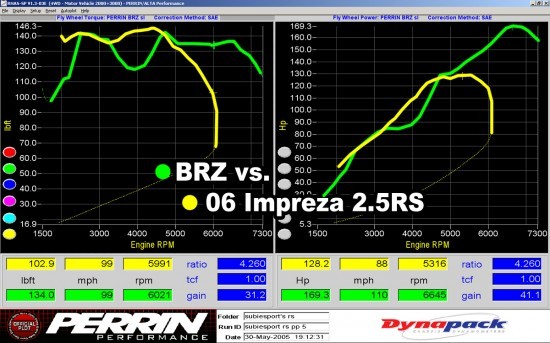 Here is another 2.5RS, but this time its modified with cams, pistons, and tuning. Even then its still no match.
Here is another 2.5RS, but this time its modified with cams, pistons, and tuning. Even then its still no match.
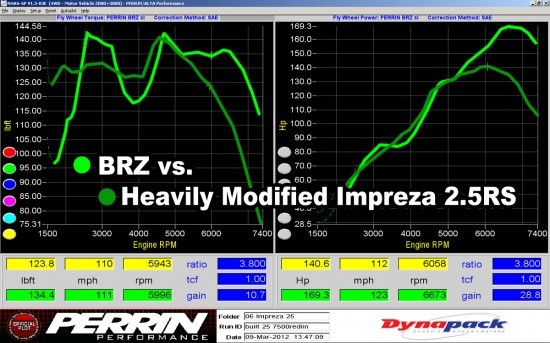 Lastly is a comparison of a MINI Cooper S and BRZ. The MINI's dyno very high for some reason. But you can see a car that has similar overall Wheel HP to the BRZ, but the MINI has way more torque. Boost is the answer here.
Lastly is a comparison of a MINI Cooper S and BRZ. The MINI's dyno very high for some reason. But you can see a car that has similar overall Wheel HP to the BRZ, but the MINI has way more torque. Boost is the answer here.
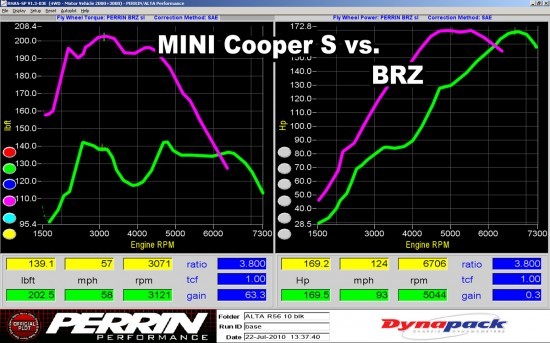
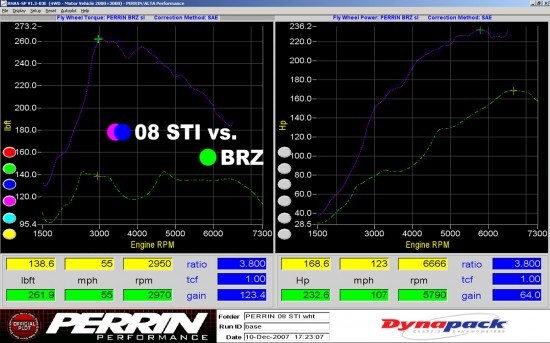 This is just a snippet of what is to come with this car. Be on the look out for even more dyno results!
This is just a snippet of what is to come with this car. Be on the look out for even more dyno results!


